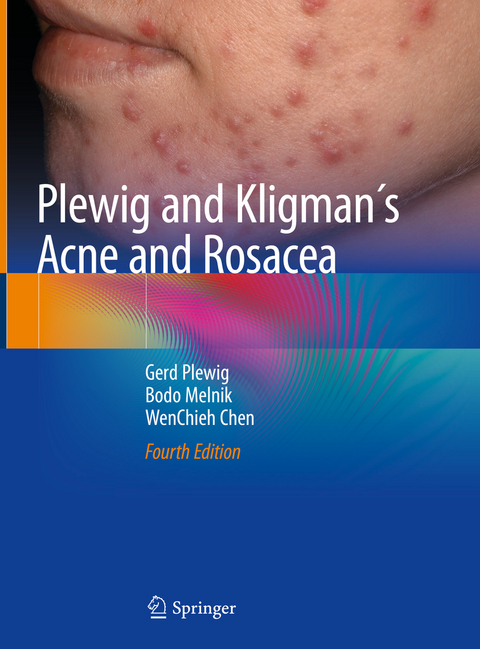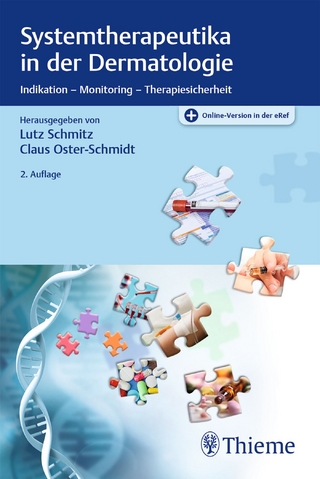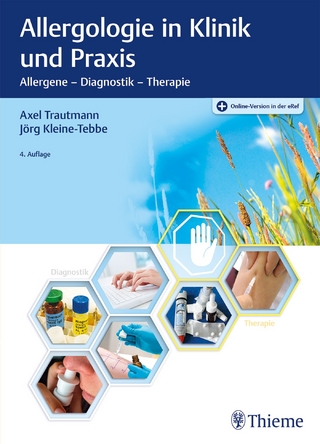
Plewig and Kligman´s Acne and Rosacea
Springer International Publishing (Verlag)
978-3-319-49273-5 (ISBN)
Since it was first published, Acne and Rosacea has become a well-known classic. This fourth edition has been completely revised and updated, with entirely new chapters on topics such as etiopathogenesis, auto-inflammatory acne syndromes, the role of nutrition, and novel therapies. The text is supplemented by selected references and a wealth of clinical and histopathological pictures, including additional high-definition photographs. The book is designed for all those physicians – dermatologists, general practitioners, pediatricians, gynecologists, pharmacologists, and surgeons – who must identify and treat the many different forms of acne and rosacea.
Gerd Plewig served as Professor and Chairman at the Department of Dermatology, Ludwig Maximilian University, Munich, Germany from 1991 to 2006. His other academic appointments have included Professor and Chairman, Department of Dermatology, University of Düsseldorf, and Medical Director, Clinical Center, School of Medicine, Ludwig-Maximilian-University, Munich. Dr. Plewig has been an author or editor of numerous previous books and has served on the editorial and advisory boards of many journals. He has received various awards and honors, including several Gold Medals from the American Academy of Dermatology. He became a Fellow of the Royal College of Physicians London (FRCP) in 1997, and was awarded the title Doctor of Medicine honoris causa by the Charles University Prague, Czech Republic 2002; Medical University Wroclaw, Poland 2005; and the Comenius University of Bratislawa, Slovakia 2007.Bodo Melnik is an Associate Professor at the University of Osnabrück, Germany, where he has taught dermatology, trichology and cosmetology since 1991. A member of the European Society for Dermatological Research (ESDR), Dr. Melnik has been trained in lipid research as a visiting scientist at the Cardiovascular Research Institute, UCSF, USA, and subsequently worked as head of the lipid research laboratory of the Department of Dermatology at Heinrich Heine University in Düsseldorf, Germany. After completing his teaching qualification as a professor, Dr. Melnik was awarded the Felix-Hoppe-Seyler Prize by the German Society for Laboratory Medicine. Since 1990, he has been working as senior dermatologist in his outpatient clinical practice in Gütersloh. Dr. Melnik is coeditor of the Journal of Translational Medicine and author of more that 100 articles and book chapters in international medical journals. His research interests include acne, rosacea, lipid and milk metabolism, and nutrition. WenChieh Chen is the former head of a dermatology department in Taiwan and senior consultant in dermatology of various university hospitals in Germany. Most recently he has been working at the Technical University and Ludwig Maximilian University, both in Munich, Germany. His major interest and research field is hormone-mediated skin disorders. Since 2016 he has served at the IZZ-Immunologie Zentrum Zürich and MediX Praxis in Zürich, Switzerland. During his clinical practice in dermatology and venereology, he had the opportunity to teach as an adjunct professor at the Technical University of Munich and as visiting professor in many universities throughout China.
Preface.- I Acne.- Etiology, Pathophysiology, and Nosology of Acne.-Prevalence.- A Precis of Pathogenesis.-Anatomy of Follicles.-Epidermal Lipids.- Sebaceous Glands, Micro-organisms.- Endocrinology of Acne.-The Evolution of the Comedo.-Dynamics of Primary Comedo Formation.- Dynamics of Secondary Comedo Formation.- Dynamics of Inflammation, Inflammatory Lesions and Sequels.-Scope of Scar.- Classification of Acne.- Acne in Animals: Canine and Feline Acne.-Animal Models.- Human Sebocyte Culture, Acne in Childhood, Acne Comedonica (Comedonal Acne).- Acne Papulopustulosa (Papulopustular Acne).- Acne Conglobata.- Acne Inversa.-Acne Fulminans.- SAPHO Syndrome.- Solid Facial Persistent Edema in Acne.- Acne Mechanica.- Back Acne.- Acne Tropicalis (Tropical Acne).- Postadolescent Acne in Women.- Premenstrual Acne.- Perimenopausal and Postmenopausal Acne.- Polycystic Ovary Syndrome and SAHA Syndrome.- Congenital Adrenal Hyperplasia.- Cushing Syndrome.-Androgen Excess, Excoriations.- Acne Venenata, Chloracne.-Solar Comedones (Favre-Racouchot Disease.- Acne Aestivalis (Mallorca Acne).- Radiation-induced Comedones, PAPA Syndrome.- Ectrodactyly, Soft-tissue Syndactyly, and Nodulocystic Acne.- Apert Syndrome.- Familial Dyskeratotic Comedones.- Haber Syndrome.- Acne-free Nevus and Clonal Acne.- Atrophodermia Vermiculata, Acneiform Eruptions.- Steroid Acne.- Amineptine Acne.- Ecstasy Pimples.- II Rosacea.- Prevalence.- Etiology and Pathogenesis.- Clinical Findings of Rosacea.- Histopathology of Rosacea.- Laboratory Findings of Rosacea.- Differential Diagnosis of Rosacea.- Treatment of Rosacea.- III Acne-like Disorders.- Perioral Dermatitis.- Demodex folliculorum.- Gram-negative Folliculitis.- Necrotizing Lymphocytic Folliculitis (Acne Necrotica) .- Sebaceous Gland Hyperplasia.- Steatocystoma Multiplex.- Steatocystoma Simplex.- Eruptive Vellus Hair Cysts.- Nevus Comedonicus.- Dilated Pore.- Pilar Sheath Acanthoma.- Omphalolith: The Ugly Navel .- Keratosis Pilaris.- Pseudofolliculitis Barbae.- Osteoma Cutis.- Minocycline-induced Hyperpigmentation.- IV Treatment of Acne.- History of Therapy: Post, Present and Future.- Strategic Approaches to the Treatment of Acne.- Topical Treatment.- Systemic Treatment.- Physical Therapy.- V Miscellaneous.- X-Ray Therapy: A Historical Note.- Dermabrasion.- Excision.- Punch-Graft Elevation or Punch-Graft Transplant.- Dermal Filler Substances: Collagen.- Camouflage.- Psychosocial Aspects of Acne.- Spontaneous Involution of Acne.- Subject Index.
"This book covers the compendium of acne and acne-related diseases, as well as acne mimics. It contains extensive, high-quality illustrations. ... this is a useful reference for any healthcare provider caring for patients with acne and acneiform disorders. ... This is a useful addition to the library of healthcare providers treating patients with acne, especially those who wish to delve into the subject in greater depth." (Renata H. Mullen, Doody's Book Reviews, 27 September, 2019)
“This book covers the compendium of acne and acne‐related diseases, as well as acne mimics. It contains extensive, high-quality illustrations. … this is a useful reference for any healthcare provider caring for patients with acne and acneiform disorders. … This is a useful addition to the library of healthcare providers treating patients with acne, especially those who wish to delve into the subject in greater depth.” (Renata H. Mullen, Doody's Book Reviews, 27 September, 2019)
| Erscheinungsdatum | 26.04.2019 |
|---|---|
| Zusatzinfo | XXVI, 671 p. 277 illus., 248 illus. in color. |
| Verlagsort | Cham |
| Sprache | englisch |
| Maße | 210 x 279 mm |
| Themenwelt | Medizin / Pharmazie ► Medizinische Fachgebiete ► Dermatologie |
| Medizin / Pharmazie ► Studium | |
| Schlagworte | Acne-like disorders • Acne models • allergies • Allergology • Clinical and internal medicine • Clonal acne • Dermatitis • Dermatology • Dyskeratotic comedones • general practice • General Practice / Family Medicine • Haber syndrome • Internal Medicine • Medicine • Medicine: general issues • Nutrition and Acne • Paediatric medicine • Pediatrics • skin diseases • Skin in childhood • Skin in puberty • systemic treatment • Topical Treatment |
| ISBN-10 | 3-319-49273-X / 331949273X |
| ISBN-13 | 978-3-319-49273-5 / 9783319492735 |
| Zustand | Neuware |
| Informationen gemäß Produktsicherheitsverordnung (GPSR) | |
| Haben Sie eine Frage zum Produkt? |
aus dem Bereich


